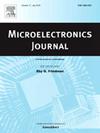A fast LMS-based digital background calibration technique for 16-bit SAR ADC with modified shuffling scheme
IF 1.9
3区 工程技术
Q3 ENGINEERING, ELECTRICAL & ELECTRONIC
引用次数: 0
Abstract
-This paper introduces a modified shuffling scheme to achieve less overhead in ADC, lower power consumption for digital calibration and higher update frequency. Different-size unit capacitors are used in the shuffling, which reduces the number of switches and capacitors by almost half while remaining complexity of the digital circuit unchanged. Additionally, a novel LMS-based digital background calibration technique suitable for split-based ADC is proposed. Fast convergence and linear calibration are achieved with the improved gradient descent algorithm, which uses Momentum and Nesterov accelerated gradient (NAG). The convergence speed is found to be over 10 times faster than typical LMS algorithm and maintain calibration accuracy in MATLAB simulation of a 16-bit, 1 MS/s SAR ADC.
求助全文
约1分钟内获得全文
求助全文
来源期刊

Microelectronics Journal
工程技术-工程:电子与电气
CiteScore
4.00
自引率
27.30%
发文量
222
审稿时长
43 days
期刊介绍:
Published since 1969, the Microelectronics Journal is an international forum for the dissemination of research and applications of microelectronic systems, circuits, and emerging technologies. Papers published in the Microelectronics Journal have undergone peer review to ensure originality, relevance, and timeliness. The journal thus provides a worldwide, regular, and comprehensive update on microelectronic circuits and systems.
The Microelectronics Journal invites papers describing significant research and applications in all of the areas listed below. Comprehensive review/survey papers covering recent developments will also be considered. The Microelectronics Journal covers circuits and systems. This topic includes but is not limited to: Analog, digital, mixed, and RF circuits and related design methodologies; Logic, architectural, and system level synthesis; Testing, design for testability, built-in self-test; Area, power, and thermal analysis and design; Mixed-domain simulation and design; Embedded systems; Non-von Neumann computing and related technologies and circuits; Design and test of high complexity systems integration; SoC, NoC, SIP, and NIP design and test; 3-D integration design and analysis; Emerging device technologies and circuits, such as FinFETs, SETs, spintronics, SFQ, MTJ, etc.
Application aspects such as signal and image processing including circuits for cryptography, sensors, and actuators including sensor networks, reliability and quality issues, and economic models are also welcome.
 求助内容:
求助内容: 应助结果提醒方式:
应助结果提醒方式:


